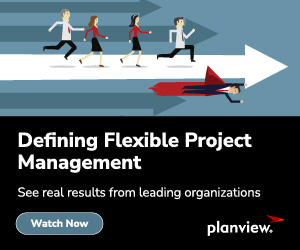
Leaders must balance detailed short-term planning flexibility and strategic alignment to manage portfolios effectively. Most portfolio management platforms emphasize only one of these competencies at the expense of the other. For example, organizations striving for adaptability may stray too far from strategic goals, while organizations emphasizing strategy may be too rigid to react to near-term constraints.
This blog explains how leaders can reconcile the tension between adaptability and strategic alignment. With the right processes and tools, organizations can embrace the kind of flexibility that enables them to capitalize on opportunities without sacrificing long-term goals.
What is Adaptive Portfolio Management?
Adaptive portfolio management is geared towards short- and medium-term solutions. It’s about making more minor decisions more frequently—sometimes even daily—to stay efficient as conditions change.
Adaptable teams use recent historical data and short-term projections, drilling down to the individual resource level to optimize workflows. Using cost management and capacity metrics, teams can quickly adjust plans, adapting to changes in project priorities, scope, market conditions, or resource constraints. These small, frequent adjustments yield significant benefits over time.
Vad är strategisk portföljförvaltning?
Strategic portfolio management focuses on the business’s long-term success and health. Leaders must make high-level decisions and trade-offs across complex portfolios and projects with an eye to overall business objectives. These decisions, at best, occur monthly or quarterly. Annual reviews are also common but can lead to quick detachment from business realities in this modern, fast-paced digital era.
The data used in strategic portfolio management is future-oriented, often looking multiple years ahead. Metrics typically relate to business outcomes such as profits, losses, employee happiness, and customer satisfaction. Aggregated data about resources and costs is also helpful.
Challenges with Portfolio Management Solutions
Some solutions support adaptive management, while others support strategic management. These two approaches have significant differences. For example, they often employ different datasets built for distinct use cases and workflows.
It is rare to find a single platform that can accomplish both—that would be akin to building a single watercraft that could serve as both a speedboat and a cruise ship.
Another difference is the user base. Many stakeholders—typically hundreds or thousands—can participate in the adaptive process. However, relatively few people—usually senior in the organization—participate in the strategic process.
The challenge lies in integrating these two unique and essential capabilities. When organizations favor one over the other, they risk missing opportunities and losing sight of long-term goals.
What if you are constantly prioritizing adaptivity?
When companies get too focused on being overly flexible and adaptive, they typically try one of two things: either they (1) force-fit strategic processes into decisions made with an ill-suited tool, or (2) strategic processes become siloed and static and live somewhere offline, for example, in an Excel spreadsheet.
What you end up with is a disjointed process where daily decisions neglect long-term strategy and strategic planners lack valuable insights into daily work. They are forced to rely on manual reporting, which is error-prone and time-consuming.
What if you are unmovable in adherence to strategy?
Though less common, this situation is no less detrimental. Agility is essential in today’s fast-changing business environment.
Without an adaptable portfolio management solution, you’ll miss opportunities, get stuck in a rut, and end up delivering projects months or years behind schedule.
Combining strategy and adaptability
Portfolio managers need a streamlined and collaborative approach to reap the benefits of both strategic and adaptable management. On the strategy side, leaders need an easy and timely way to visualize data about work happening on the ground. Simultaneously, leaders at the team level need to understand how their daily decisions help or hinder overarching business goals.
Integrating adaptive and strategic solutions is made possible by Planview AdaptiveWork and Planview Advisor.
Here’s how it works in three steps:
1. Build Plans in Planview AdaptiveWork
Planview AdaptiveWork helps you focus on execution. It allows you to track productivity, visualize collaboration, tackle risks, and manage resource capacity.
2. Connect Plans to Strategy with Planview Advisor
Planview Advisor keeps you on track to meet long-term business goals. With in-depth, high-level financial data, you can analyze risks and rewards without getting lost in the weeds of team metrics. Essentially, Advisor’s insights help you make strategy-aligned decisions about your projects in AdaptiveWork, saving you time, resources, and administrative headaches.
3. Use Planview Advisor’s scenario analysis to weigh alternatives
Planview Advisor also has built-in scenario analysis capabilities that show how your goals would be affected if you made certain trade-offs. In these “what-if” analyses, you can visualize the impact of delays, budget overruns, and alternative resource allocations on your portfolio value.
When building scenarios, you can layer in existing initiatives, future projects, and potential investments, partnerships, or acquisitions. Planview’s embedded risk analysis capabilities, including Monte Carlo simulations, allow you to grasp the implications of alternative courses of action quickly. This is forward-looking planning at its most comprehensive.
Do More with Dual Threat Portfolio Management
Integrating adaptive and strategic management is critical for the long-term profitability of your business. On the one hand, teams and team leaders, who are closest to the work, are in the best position to adapt to risks and seize opportunities as they arise. On the other hand, strategic leaders need to make long-term plans with high-level insights. An integrated, dual-pronged approach is the surest way to meet every leader’s needs.
Planview AdaptiveWork and Planview Advisor provide a streamlined data flow between short—and long-term planning. This reduces manual work, allowing leaders to make intelligent decisions faster. Scenario analysis helps you visualize outcomes holistically across your portfolio, enabling you to pursue goals confidently.
See how our integrated approach to product portfolio management can help your team move with speed and confidence in this demo.




